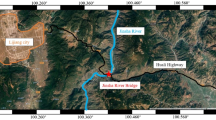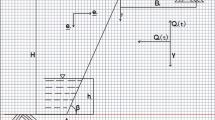Abstract
Obsequent rock slopes are often thought to be more stable than consequent slopes and passive sliding is unlikely to occur under earthquake loading. However, failures in obsequent rock slopes were indeed observed in recent large earthquakes. This paper presents a time–frequency solution to the seismic stability of obsequent rock slopes fully considering the time–frequency characteristics of earthquake waves. Large-scale shaking table tests were conducted to illustrate the application of the time–frequency method to an obsequent rock slope containing multiple weak layers with a small dip angle. The seismic stability of the obsequent rock slope is analyzed combining the time–frequency method, outcomes from the shaking table test, and conventional pseudo-static and dynamic numerical analyses. The results show that passive sliding can develop in the obsequent rock slope when taking the time–frequency components of the earthquake waves and the vertical seismic force into account. The middle–upper part of the obsequent rock slope is more vulnerable to seismic damage. The slope bulges under the earthquake loading; the maximum permanent surface displacement occurs at the middle–upper part of the slope, rather than the slope crest. Additionally, the response of seismic safety factor lags behind the responses of acceleration and surface displacement.

(after Huang et al. 2013)

(modified from Hoek and Bray 1981)












Similar content being viewed by others
Abbreviations
- \(\alpha_{1}\) :
-
Incident angle
- \(\alpha^{\prime}_{1}\) :
-
Reflection angle of reflection P waves
- ξ min :
-
Minimum critical damping ratio
- η H :
-
Horizontal earthquake influence coefficients
- η V :
-
Vertical earthquake influence coefficients
- θ :
-
Dip angle
- λ :
-
Lame constant
- μ :
-
Poisson’s ratio
- ρ :
-
Density
- σ 0 :
-
Normal component of slope gravity
- \(\sigma_{\text{n}}\) :
-
Normal stress
- \(\tau_{0}\) :
-
Tangential component of slope gravity
- \(\tau_{\text{s}}\) :
-
Shear stress
- φ :
-
Internal friction angle
- ω :
-
Instantaneous frequency
- ω min :
-
Minimum central frequency
- a :
-
Acceleration
- A H :
-
Horizontal peak acceleration
- A i :
-
Area of analytical unit i
- A V :
-
Vertical peak acceleration
- c :
-
Cohesion
- C a :
-
Scaling factor for acceleration
- C L :
-
Scaling factor for geometric dimension
- C ρ :
-
Scaling factor for mass density
- EMD:
-
Empirical mode decomposition
- F s :
-
Sliding force
- F a :
-
Resistance force
- G 0 :
-
Slope gravity
- HHT:
-
Hilbert–Huang transform
- IMF:
-
Intrinsic mode function
- K p :
-
Pseudo-static safety factor
- K s :
-
Seismic safety factor
- \(k_{x}^{(j)}\) :
-
Wave vectors of \(S_{0}^{j}\) in X direction
- \(k_{z}^{(j)}\) :
-
Wave vectors of \(S_{0}^{j}\) in Z direction
- L :
-
Geometric dimension
- l :
-
Length
- m :
-
Mass
- n :
-
Number of analytical units
- PGA:
-
Peak ground acceleration
- \(S_{0}^{j}\) :
-
Elastic displacement of seismic wave \(S^{j}\)
- t :
-
Time
References
Ambraseys NN, Douglas J (2003) Near-field horizontal and vertical earthquake ground motion. Soil Dyn Earthq Eng 23:1–18
Aydan Ö (1989) The stabilisation of rock engineering structures by rockbolts. Doctorate Thesis, Nagoya University, Nagoya, Japan
Aydan Ö (2016) Large rock slope failures induced by recent earthquake. Rock Mech Rock Eng 49:2503–2524
Aydan Ö, Shimizu Y, Kawamoto T (1992) The stability of rock slopes against combined shearing and sliding failures and their stabilisation. In: International symposium on rock slopes, New Delhi, pp 203–210
Aydan Ö, Ohta S, Hamada M (2009) Geotechnical evaluation of slope and ground failures during the 8 October 2005 Muzaffarabad Earthquake, Pakistan. J Seismol 13(3):399–413
Aydan Ö, Ulusay R, Hamada M, Beetham D (2012) Geotechnical aspects of the 2010 Darfield and 2011 Christchurch earthquakes of New Zealand and geotechnical damage to structures and lifelines. Bull Eng Geol Environ 71(4):637–662
Baker R, Shukha R, Operstein V, Frydman S (2006) Stability charts for pseudo-static slope stability analysis. Soil Dyn Earthq Eng 26:813–823
Boore DM (1972) A note on the effect of simple topography on seismic SH waves. Bull Seismol Soc Am 62:275–284
Buckingham E (1914) On physical similar systems; illustration of the use of dimensional equations. Phys Rev 4:354–376
Cavallaro A, Ferraro A, Grasso S, Maugeri M (2012) Topographic effects on the Monte Po Hill in Catania (Italy). Soil Dyn Earthq Eng 43:97–113
Celebi M (1987) Topographic and geological amplification determined from strong-motion and aftershock records of the 3 March 1985 Chile earthquake. Bull Seismol Soc Am 77:1147–1167
Chen X, Li JC, Cai MF, Zou Y, Zhao J (2015) Experimental study on wave propagation across a rock joint with rough surface. Rock Mech Rock Eng 48:2225–2234
Chinese code GB50011-2010 (2010) Code for seismic design of buildings. Building Industry Press, Beijing
Crosta GB, Frattini P, Agliardi F (2013) Deep seated gravitational slope deformations in the European Alps. Tectonophysics 605:13–33
Deng QL, Fu M, Ren XW, Liu FZ, Tang HM (2017) Precedent long-term gravitational deformation of large scale landslides in the Three Gorges reservoir area, China. Eng Geol 221:170–183
Fan G, Zhang LM, Zhang JJ, Yang CW (2017) Time-frequency analysis of instantaneous seismic safety of bedding rock slopes. Soil Dyn Earthq Eng 94:92–101
FLAC (2000) FLAC users’ guide. Itasca Consulting Group, Inc., Minneapolis
Hoek E, Bray JW (1981) Rock slope engineering. Institute of Mining and Metallurgy, London
Huang NE, Shen Z, Long SR, Wu MC, Shih HH, Zheng QA, Yen NC, Tung CC, Liu HH (1998) The empirical mode decomposition and Hilbert spectrum for nonlinear and non-stationary time series analysis. Proc R Soc A 454:903–995
Huang NE, Shen Z, Long SR (1999) A new view of nonlinear water waves: the Hilbert spectrum. Annu Rev Fluid Mech 31:417–457
Huang NE, Wu ML, Qu WD, Long SR, Shen SS (2003) Applications of Hilbert–Huang transform to non-stationary financial time series analysis. Appl Stoch Model Bus Ind 19:245–268
Huang Y, Zhang W, Xu Q, Xie P, Hao L (2012) Run-out analysis of flow-like landslides triggered by the Ms 8.0 2008 Wenchuan earthquake using smoothed particle hydrodynamics. Landslides 9:275–283
Huang RQ, Zhao JJ, Ju NP, Li G, Lee ML, Li YR (2013) Analysis of an dip-angle landslide triggered by the 2008 Wenchuan earthquake in China. Nat Hazards 68:1021–1039
Latha GM, Garaga A (2010) Seismic stability analysis of a Himalayan rock slope. Rock Mech Rock Eng 43:831–843
Liu HX, Xu Q, Li YR, Fan XM (2013) Response of high-strength rock slope to seismic waves in a shaking table test. Bull Seismol Soc Am 103:3012–3025
Perino A, Zhu JB, Li JC, Barla G, Zhao J (2010) Theoretical methods for wave propagation across jointed rock masses. Rock Mech Rock Eng 43:799–809
Poon CW, Chang CC (2007) Identification of nonlinear elastic structures using empirical mode decomposition and nonlinear normal modes. Smart Struct Syst 3:423–437
Qi SW, Xu Q, Lan HX, Zhang B, Liu JY (2009) Spatial distribution analysis of landslides triggered by 2008 5.12 Wenchuan earthquake, China. Eng Geol 116:95–108
Rehman N, Mandic DP (2010) Multivariate empirical mode decomposition. Proc R Soc A 466:1291–1302
Rehman N, Mandic DP (2011) Filter bank property of multivariate empirical mode decomposition. IEEE Trans Signal Process 59:2421–2426
Scott AA, Sitar N, Lysmer J, Deng N (1997) Topographic effect on the seismic response of steep slopes. Bull Seismol Soc Am 87:701–709
Sepúlveda SA, Murphy W, Jibson RW, Petley DN (2005) Seismically induced rock slope failures resulting from topographic amplification of strong ground motions: the case of Pacoima Canyon, California. Eng Geol 80:336–348
Shimizu Y, Aydan Ö, Ichikawa Y, Kawamoto T (1986) A model study on dynamic failure modes of discontinuous rock slopes. In: International symposium on engineering complex rock formation, Beijing, pp 732–738
Shimizu Y, Aydan Ö, Ichikawa Y, Kawamoto T (1988) An experimental study on the seismic behavior of discontinuous rock slopes (in Japanese). In: The 42nd annual meeting of Japan society of civil engineers, pp 386–387
Sun P, Yin YP, Wu SR, Chen LW (2011) Does vertical seismic force play an important role for the failure mechanism of rock avalanches? A case study of rock avalanches triggered by the Wenchuan earthquake of May 12, 2008, Sichuan China. Environ Earth Sci 66:1285–1293
Xu Q, Fan XM, Huang RQ, Westen CV (2009) Landslide dams triggered by the Wenchuan earthquake, Sichuan Province, south west China. Bull Eng Geol Environ 68:373–386
Yin YP, Li B, Wang WP (2015) Dynamic analysis of the stabilized Wangjiayan landslide in the Wenchuan Ms 8.0 earthquake and aftershocks. Landslides 12:537–547
Zhang YB, Zhao J, Chen GQ, Zheng L, Li YG (2015) Effects of vertical seismic force on initiation of the Daguangbao landslide induced by the 2008 Wenchuan earthquake. Soil Dyn Earthq Eng 73:91–102
Zhang J, Peng WH, Liu FY, Zhang HX, Li ZJ (2016a) Monitoring rock failure processes using the Hilbert–Huang Transform of acoustic emission signals. Rock Mech Rock Eng 49:427–442
Zhang ZL, Wang T, Wu SR, Tang HM (2016b) Rock toppling failure mode influenced by local response to earthquakes. Bull Eng Geol Environ 75:1361–1375
Zhao J, Cai JG, Zhao XB, Li HB (2008) Dynamic model of fracture normal behavior and application to prediction of stress wave attenuation across fractures. Rock Mech Rock Eng 41:671–693
Acknowledgements
This research was financially supported by the Research Grants Council of the Hong Kong Special Administrative Region (16202716), the National Key Research and Development Plan of China (2017YFC0504901) and the Fundamental Research Funds for the Central Universities (20822041B4038).
Author information
Authors and Affiliations
Corresponding author
Additional information
Publisher's Note
Springer Nature remains neutral with regard to jurisdictional claims in published maps and institutional affiliations.
Rights and permissions
About this article
Cite this article
Fan, G., Zhang, L., Zhang, J. et al. Analysis of Seismic Stability of an Obsequent Rock Slope Using Time–Frequency Method. Rock Mech Rock Eng 52, 3809–3823 (2019). https://doi.org/10.1007/s00603-019-01821-9
Received:
Accepted:
Published:
Issue Date:
DOI: https://doi.org/10.1007/s00603-019-01821-9




